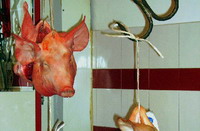Minnesota slaughterhouse workers get sick thanks to pig-brain removal technique
On the slaughterhouse floor at Quality Pork Processors Inc. workers cut up pigs' heads and then shoot compressed air into the skulls until the brains come spilling out.

But now the grisly practice has come under suspicion from U.S. health authorities.
Over eight months from last December through July, 11 workers at the Minnesota plant - all of them employed at the head table - developed numbness, tingling or other neurological symptoms, and some scientists suspect inhaled airborne brain matter may have somehow triggered the illnesses.
The use of compressed air to remove pig brains was suspended at Quality Pork earlier this week while authorities try to get to the bottom of the mystery.
"I'm still in shock, I guess," said 37-year-old Susan Kruse, who worked at the plant for 15 years until she got too weak to do her job last February. "But it was very surprising to hear that there was that many other people that have gotten this."
Five of the workers - including Kruse, who has been told she may never work again - have been diagnosed with chronic inflammatory demyelinating polyneuropathy, or CIDP, a rare immune disorder that attacks the nerves and produces tingling, numbness and weakness in the arms and legs, sometimes causing lasting damage.
New cases of CIDP occur at the rate of one or two per 100,000 people each year, according to Dr. P. James B. Dyck of the Mayo Clinic.
Minnesota health officials said there is no evidence the public is at risk - either from those afflicted or from any food leaving the plant, which supplies Hormel Foods Inc.
The working theory from two Mayo Clinic neurologists treating the workers: Exposure to pig brain tissue scattered by the compressed air triggered the illnesses.
"As we've investigated these patients, we have information that suggests very strongly that the immune system is activated very strongly in a very compelling way," said Dr. Daniel Lachance.
Compressed air could turn some brain matter into a mist that could be inhaled by workers, said Mike Doyle, a microbiologist who heads the University of Georgia's Center for Food Safety. Or the workers may have come into contact with something dangerous and then touched their noses or mouths, he said.
Scientists have yet to figure out if there is something in the brain matter that could be causing the symptoms.
"The hard part will be identifying the causative agent and associating that with the animal, showing that the animal carries it," Doyle said.
Minnesota Health Department spokesman Doug Schultz said the agency is looking into the theory but has not ruled out other causes.
Quality Pork has not said what it does with the pork brains. Sold fresh and in cans, pork brains can be fried and eaten in sandwiches or gravy. But it is a small market, and the American Meat Institute, which represents most U.S. pork processors, does not even track sales.
Exactly how many of the plant's 1,300 employees worked at the head table is unclear; Quality Pork's chief executive did not return calls. Kruse said there were 11 workers at the head table on any given shift, but the lineup changed because of turnover or because people were assigned other jobs.
In a rapid-fire process that is noisy, smelly and bloody, severed pigs' heads are cut up at the head table at a rate of more than 1,100 an hour. Workers slice off the cheek and snout meat, then insert a nozzle in the head and blast air inside until the light pink mush that is the brain tissue squirts out from the base of the skull.
Kruse, whose job was to remove meat from the back of the animals' heads, said she does not recall any spray or mist from the de-braining. The head-table workers were protected by safety glasses, helmets, gloves and belly guards, but none wore anything over their mouths or noses, she said.
Head-table workers are now required to wear plastic face shields and protective plastic or rubber sleeves, the Health Department said.
The use of compressed air to remove hog brains is relatively uncommon, according to industry officials. That is because many plants do not even remove them. And some of the processors that do extract brains simply split the hogs' skulls open.
Some of the biggest pork processors - Tyson Foods Inc., JBS Swift & Co. and Cargill Inc. - said they do not handle brains because the market is not big enough. No pork workers at Tyson, Cargill or JBS Swift have reported symptoms similar to those of the Quality Pork employees, the companies said.
CIDP attacks the lining around the nerves, slowing or blocking the brain's signals to the muscles. But exactly what triggers the attack is unknown.
Victims can recover fairly quickly if the illness is caught early, said Dr. Kenneth Gorson, a neurologist at St. Elizabeth's Medical Center in Boston.
Subscribe to Pravda.Ru Telegram channel, Facebook, RSS!





